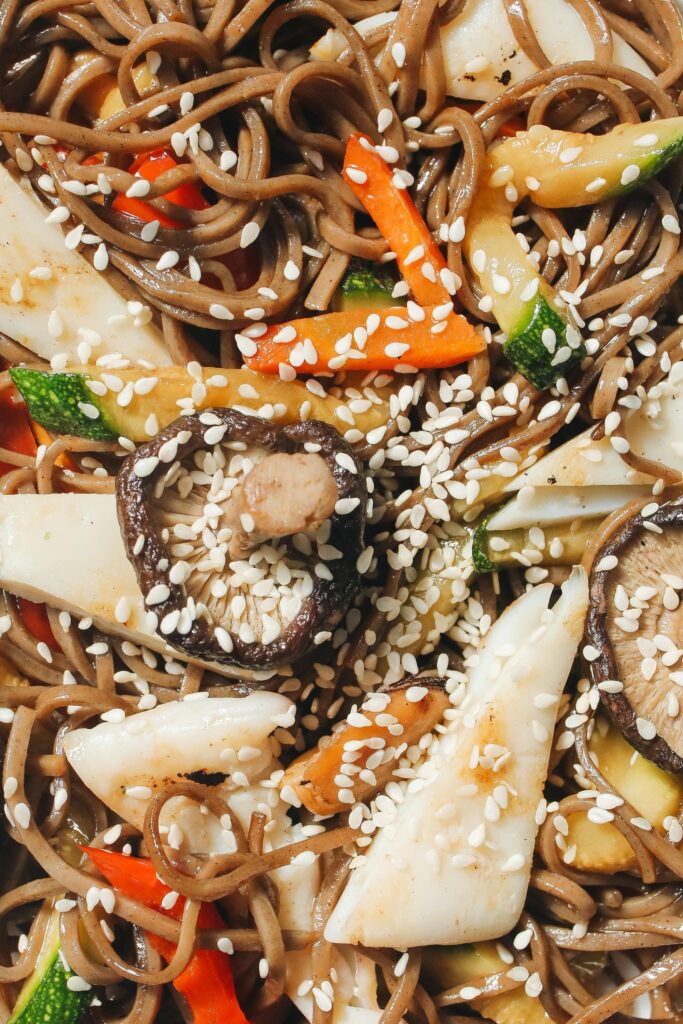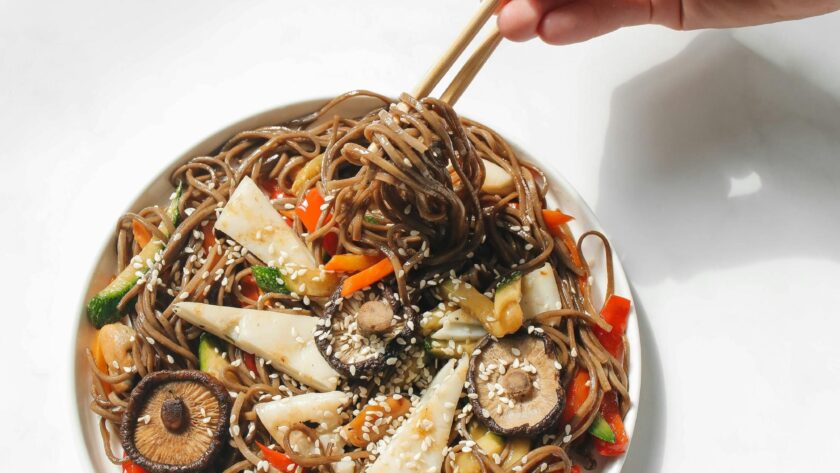Sesame Soba Noodles are a delightful fusion of nutty flavors and light, chewy noodles. This dish, rooted in Japanese cuisine, is both simple to prepare and versatile. Whether you need a quick lunch, a refreshing side dish, or a light dinner, these noodles fit the bill. Packed with healthy ingredients, this recipe is perfect for vegetarians, vegans, or anyone looking for a nourishing yet delicious meal. Additionally, it’s a wonderful way to incorporate wholesome buckwheat soba noodles into your diet. With this guide, you’ll learn how to make Sesame Soba Noodles recipe that are bursting with flavor, texture, and nutrition.
Ingredients for Sesame Soba Noodles
Below is a detailed list of ingredients, along with their approximate calorie counts:
For the Noodles:
- Soba noodles (200 grams): 400 calories
- Sesame oil (2 tablespoons): 240 calories
- Soy sauce (3 tablespoons, low sodium): 30 calories
- Rice vinegar (1 tablespoon): 10 calories
- Honey or maple syrup (1 tablespoon): 60 calories
- Ginger (1 tablespoon, grated): 5 calories
- Garlic (2 cloves, minced): 10 calories
- Red pepper flakes (1/2 teaspoon): 0 calories
For the Toppings:
- Sesame seeds (2 tablespoons, toasted): 100 calories
- Green onions (2 stalks, sliced): 10 calories
- Cucumber (1 small, julienned): 15 calories
- Carrot (1 medium, shredded): 25 calories
- Cilantro (a handful, chopped): 5 calories
Total Calories (Approximate): 910 calories (serves 2-3 people)
Step-by-Step Instructions for Sesame Soba Noodles
1: Prepare the Soba Noodles
- Cook the noodles: Bring a large pot of water to a boil. Add the soba noodles and cook according to the package instructions (usually 5-7 minutes). Avoid overcooking as soba noodles can become mushy.
- Rinse the noodles: Drain the noodles in a colander and rinse under cold running water. This step is crucial to remove excess starch and keep the noodles from sticking together.
- Set aside: Toss the noodles with a teaspoon of sesame oil to prevent clumping while you prepare the sauce.
2: Make the Sesame Sauce
- Combine wet ingredients: In a small bowl, whisk together soy sauce, rice vinegar, sesame oil, and honey or maple syrup.
- Add aromatics: Stir in the grated ginger, minced garlic, and red pepper flakes for an extra kick.
- Taste and adjust: Taste the sauce and adjust the flavors to your liking. If you prefer a sweeter profile, add a little more honey; for more tang, add extra rice vinegar.
3: Toss the Noodles
- Combine the noodles and sauce: In a large mixing bowl, combine the soba noodles with the sesame sauce. Use tongs to toss everything evenly, ensuring the noodles are fully coated.
- Add toppings: Mix in the julienned cucumber, shredded carrot, and half of the chopped green onions. Save the remaining green onions for garnish.
4: Garnish and Serve
- Plate the noodles: Divide the noodles into bowls or plates.
- Add finishing touches: Sprinkle toasted sesame seeds, the remaining green onions, and chopped cilantro over the top. Optionally, you can add a drizzle of sesame oil for extra flavor.
- Serve immediately: These noodles taste best fresh, but they can also be enjoyed cold or at room temperature.

Why This Sesame Soba Noodles Works
This Sesame Soba Noodles recipe stands out for its balance of flavors, textures, and nutritional value:
- Flavor: The sesame oil provides a rich, nutty base, while soy sauce adds umami. Rice vinegar and ginger brighten the dish with their tangy and zesty notes.
- Texture: Soba noodles offer a satisfying chewiness, complemented by the crunch of fresh vegetables and toasted sesame seeds.
- Nutrition: Buckwheat soba noodles are a great source of protein, fiber, and essential nutrients. The vegetables contribute vitamins and antioxidants, making this dish both tasty and healthy.
- Versatility: You can customize this recipe by adding your favorite protein, such as tofu, chicken, or shrimp, or by experimenting with different vegetables and spices.
FAQs
1. Can I make this recipe gluten-free?
Yes! To make this dish gluten-free, ensure you use 100% buckwheat soba noodles and gluten-free soy sauce (tamari).
2. How do I store leftovers?
Store the noodles in an airtight container in the refrigerator for up to 3 days. Keep the toppings separate if possible, as they may lose their crunch.
3. Can I serve this dish warm?
Absolutely! While Sesame Soba Noodles are typically served cold or at room temperature, they can also be enjoyed warm. Simply toss the noodles in the sauce while they are still hot.
4. What proteins can I add?
This recipe pairs well with grilled tofu, shredded chicken, boiled eggs, or stir-fried shrimp. Adding protein transforms it into a more filling main course.
5. Are there any substitutes for sesame oil?
If you don’t have sesame oil, you can use olive oil as a substitute. However, sesame oil provides a distinct nutty flavor that’s hard to replicate.
Nutritional Breakdown (Per Serving)
- Calories: ~300-450 (depending on portion size)
- Protein: 10-12 grams
- Carbohydrates: 40-45 grams
- Fats: 10-15 grams
- Fiber: 5-7 grams
Tips for Success
- Choose quality soba noodles: Look for noodles made with 100% buckwheat for a richer flavor and higher nutritional value.
- Toast your sesame seeds: Toasting enhances their nutty flavor. Simply heat them in a dry skillet over medium heat for 2-3 minutes until golden brown.
- Use fresh ingredients: Fresh vegetables and herbs elevate the dish, providing vibrant flavors and textures.
- Don’t skip the rinsing step: Rinsing soba noodles is essential to prevent them from clumping and becoming gummy.
Conclusion
Sesame Soba Noodles are a versatile, flavorful, and nutritious dish that’s perfect for any occasion. Whether you’re hosting a dinner party or preparing a quick meal for yourself, this recipe is sure to impress. With its balance of savory, sweet, and tangy flavors, it’s a crowd-pleaser that’s as satisfying as it is healthy. Give this recipe a try, and let the delightful taste of sesame and soba elevate your culinary repertoire!




Leave a Reply